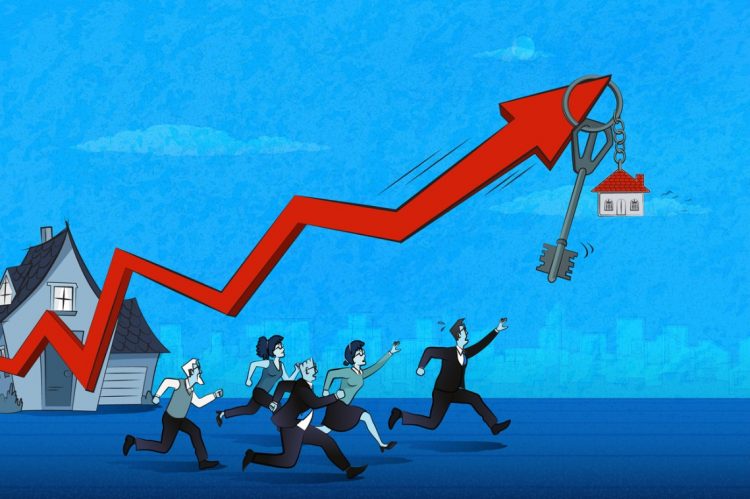It’s deja vu all over again for a lot of folks—and for homebuyers in particular.
That is what Bright MLS’ survey of its nearly 100,000 subscribers shows, as the bidding wars, high prices and low inventory of the pandemic market appear to have returned, carrying both the negatives and positives of that dynamic as real estate professionals continue to parse out the 2023 real estate landscape.
“It is maybe like a notch down from the frenzy of the height of the pandemic,” says Dr. Lisa Sturtevant, chief economist for Bright, who ran the analysis. “I think it really is perplexing for a lot of people. They thought, ‘Gosh, mortgage rates at 6.5%—how is it possible that we still have so much buyer demand?’ But there’s just those demographic fundamentals pushing buyers into the market, and just so little inventory that it is making it feel really competitive.”
Bright MLS covers five mid-Atlantic states, and it is not clear just how representative this area is to the rest of the country. But previous surveys have so far run parallel with national trends, meaning that what Bright is seeing will likely be applicable to other regions.
And the kind of market they are seeing is extremely familiar, and not what most people predicted a post-pandemic housing market would look like. Despite rampant affordability issues, first-time homebuyers are returning in force, and new inventory is disappearing off the market, often with multiple offers and usually over list price.
“It’s almost a glass half-full, half-empty sort of mindset that you want to take,” says Sturtevant. “And it also depends on whether you’re a buyer or a seller of course. But I think if someone asked me what the good news is about the market—I do think that for a buyer, the fact that home prices are moderating is good news even though there is competition.”
The bad news for buyers is that they are likely to end up in the same situations they struggled with in 2021-22. Almost three-quarters (73.4%) of listings had multiple offers, and just under one-quarter (24.2%) had five or more offers. More than half (56.5%) paid over list price.
“That’s another thing buyers are having to do—if they do find a house, they can’t come back and say to their agent, ‘Well, let’s go look at a few more.’ I think there’s this idea of really prioritizing what is most important, knowing that the market’s moving so fast,” Sturtevant adds.
Qualitatively, agents surveyed said that all these factors make the current market a struggle for buyers. Four in 10 (40%) said the process was either very or somewhat difficult. Agents representing first-time buyers were slightly more likely to report a difficult process, at 45.8%.
The other side
For sellers, though, it is a somewhat different story compared to the pandemic. Almost a third of sellers were not buyers—that is, either they were selling an investment or second home, or the sale was due to the homeowner passing away.
Sturtevant says the biggest difference now for sellers is the path they took to get here—either buying or refinancing into historically low interest rates, which they are highly motivated to keep. This “mortgage lock” effect has created a scenario where inventory is as low or lower than during the pandemic.
That might be changing, though, she says, as people eventually decide to pick up and move despite the loss of their low rate.
“I feel like we’re starting to see that shake up just a teeny bit, that people are starting to think about biting the bullet and knowing they’re moving,” she explains. “I do think in the second half of the year we’re going to see new listing activity increase because of those discretionary moves sort of coming onto the market. Still super low, still a seller’s market, still low inventory—but I think we are going to see more new listings.”
That might still be a ways away, though, at least from how the agents see it. An increasing proportion of Bright members surveyed expect low seller activity in the near future—60% in this survey, compared to only 50.7% who said the same in April. Agents are also generally expecting lower buyer activity, meaning there are still some worries about a dip or slowdown.
Sturtevant guesses that the the proportion of second-home owners and investor sellers is both a more regional phenomena, as well as something that won’t last as people who snatched up a property during the pandemic—either to rent or use for a flexible work arrangement—finish offloading their homes.
“We have been seeing revenue from Airbnbs and short-term rentals on the decline as there was sort of a boom in rental income from Airbnbs during the latter half of the pandemic,” she says. “I think that’s most prevalent in these coastal markets.”
But sellers are still mostly happy, still in control of the market, Sturtevant admits. Buyers are currently motivated to make the best offer—be it an all-cash offer, a rent-back arrangement or something else.
And though she says it might take more data to confirm, it seems that it isn’t quite as bad a market for buyers, either.
There is a group of buyers who have been looking for more than six months, but by and large, there’s also a big group of folks who have been looking just for the last month,” Sturtevant says. “I’m really interested in whether buyers are giving up, or are they sticking it out? I think that would be great to learn more about for sure.”












